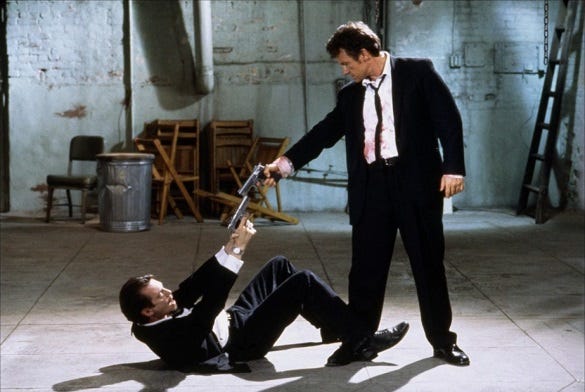Buried Treasures: Reservoir Dogs

Quentin Tarantino’s 1994 release “Pulp Fiction” is perhaps the single most important film of the past quarter-century. Its heated, in-your-face dialogue, hardened criminals, coarse language and, in particular, non-linear story line, peppered with occasional scenes of hilarious comic relief, ushered in a new era in filmmaking. Often copied but never equaled, “Pulp Fiction” made a star out of its young writer/director, Quentin Tarantino.
But many of us may not realize “Pulp Fiction” was actually Tarantino’s second film. His first was 1992’s “Reservoir Dogs,” a caustic, claustrophobic paean to the great caper noir films of yesteryear, updated for a more percipient audience. The highly original story involves a diamond robbery that we never see. Think “Deliverance” without the rape scene. We’re treated to an opening scene in which a mob boss and his son have coffee at a diner across the street from the soon-to-be crime scene, along with a bevy of hardened career criminals hired for the heist.
The men, previously unknown to one another, don’t use their real names. Instead, they refer to each other as Mr. Blue, Mr. Orange, Mr. White, Mr. Brown, and so forth. They are played by some of the best tough-guy actors of the day — Harvey Keitel, Steve Buscemi, Michael Madsen, Tim Roth, Chris Penn. The next scene takes place immediately after the robbery. Something has apparently gone wrong. One or more of the criminals has been shot. The rest of the action takes place at a nearby abandoned warehouse, in which the remaining criminals attempt to find out which of them, if any, is an informant. Here, we delight as the double-crosses accumulate like horseflies in a swamp at dusk.
Interspersed with the warehouse scenes, Tarantino gives us flashbacks highlighting the backstories of each of the primary criminals. This serves to break up the present-day action and give us some breathing room, as it were, while pulling back the covers of cynicism we instantly develop about each of these characters at the beginning. In other words, the more we learn about each of the major players, the more we understand the ongoing warehouse scene. Having seen “Pulp Fiction” before “Reservoir Dogs” (as did most filmgoers), a lot of Tarantino’s trademark effects first cultivate in the earlier picture.
While not as brilliantly effective as in “Pulp Fiction,” the non-linear screenplay is first on display in “Reservoir Dogs,” with the individual backstories shedding light on the robbery aftermath. As in “Pulp Fiction,” once the movie ends, we then want to see it again from the beginning, due to our now-complete hindsight.
“Reservoir Dogs” first introduces the Tarantino trait of uncomfortable scenes that are intentionally too long. The best of these features the great character actor Madsen as Mr. Blonde (yeah, I know he’s not really blond) torturing a police hostage for information. After slicing off the cop's ear, Madsen douses him gasoline, then continues to talk to him while holding a lit match — all while Stealer’s Wheel’s 1973 hit “Stuck In The Middle With You” plays on the radio in the background. But before the cop can be set afire, Mr. Orange (who’s passed out on the floor in the corner, due to a gunshot received during the robbery) rises to life and kills Mr. Blonde – because Mr. Orange is the informant. This stuff is classic Tarantino – from the non-dead body to the classic pop / rock oldies to the double-crosses to the mordant, uncomfortable nature of the scene itself. He’s employed these techniques for the past 20 years. This scene is the first.
While the majority of the film takes place on a barren stage, if you will, I like the fact that we don’t actually view the robbery take place. Why does Tarantino eliminate the apogee of the film? Because it isn’t truly necessary! Much as the real heft of “Deliverance” takes place after the rape scene, Tarantino has given us the longest denouement in film history —everything after the opening credits! Again, think about “Pulp Fiction.” Remember that we never see John Travolta accidentally shoot the man in the back seat of the car. We hear the gunshot, then Travolta and his cohorts spend the next 15 minutes dealing with cleaning blood off the vehicle’s interior. That’s what we have here. “Reservoir Dogs” is about the “clean-up,” if you will, of a flawed heist.
My favorite scene of all is the first. Remember in “Pulp Fiction” how audiences latched on to the humorous dialogue between Travolta and Samuel L. Jackson, as they discussed what the French call a Quarter Pounder with Cheese? Same here, but even funnier. As this tableful of career criminals plans a horrible crime, they discuss the fine details of the lyrics to Vicki Lawrence’s hit song, “The Night The Lights Went Out In Georgia.” Really. It’s a seemingly effortless marriage of downright unpleasantness coupled with meaningless everyday conversation. We find it funny, but it’s probably more realistic than screenplays in which every uttered line is pertinent to the plot.
No one has perfected this technique as well as Tarantino. In fact, no one has come close to mimicking Tarantino’s love for the cinema, processed and regurgitated from a unique perspective, and thrown back at us in classic film after classic film. I always claimed no one could watch a Stanley Kubrick film in the background. In other words, if a Kubrick film were on television, you were instantly drawn to it. You couldn’t knit, play cards, read the paper or think about anything else. Same is true of Tarantino. He’s still one of our greatest living directors, and it’s a thrill to go back and watch his very first work. That’s why “Reservoir Dogs” is this month’s Buried Treasure.



